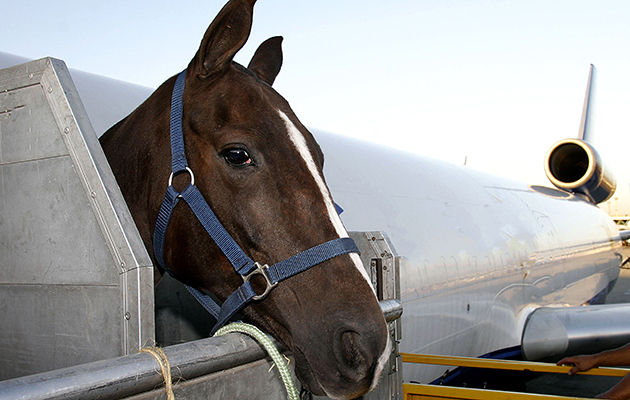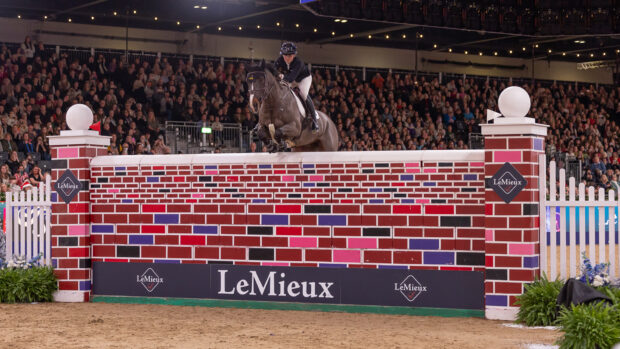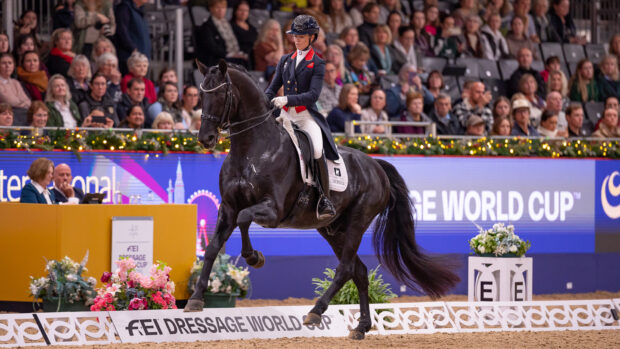Flying horses around the world requires impressive levels of organisation. Horse & Hound watches the operation swing into action at Heathrow, with horse transport company IRT ahead of a flight to Australia
A busy schedule
Around 5,000 horses fly globally each year with horse transport company IRT — every hour of every day, they have a horse in the air.
Quarantine
There has to be 14 days of quarantine either side of flying horses to Australia, but IRT does three weeks to allow for the testing. “The level of isolation is extremely detailed — the showering protocol includes washing your hair and brushing your nails,” says IRT’s European managing director Jim Paltridge.
The stalls
The stalls take up to three horses (it costs roughly £14,350 per horse to fly to Australia, including quarantine, vet and transfers fees), but clients can pay 35% more for “business class” (two horses per stall) or “first class” (single horse, 70% more), for instance for stallions or racehorses running in the Melbourne Cup.
Feeding
Each horse has two haynets — small-gauge to keep them grazing throughout — and will lose five to 15kg during the flight, but they’ll put this back on within five days.
The vet
“The IRT subcontracts a vet for the flight. This isn’t law, but once you go over 12 hours’ flying, it’s dangerous territory for shipping fever,” explains Jim. “Having a vet on board is the best way to care for them. Top-class travelling grooms are so important; they can recognise when a horse is off-colour like a mother with her child. But the vet is there for things like administering fluids if the horses aren’t drinking after eight hours.”
Loading up
Transferring the horses from lorry to stall is a slick procedure. There is a “load plan”, denoting where every horse will “sit”. The horses have been “buddied up” during quarantine, so they are used to their fellow passengers.
The lorries park alongside the stall, and the handlers pull down the ramp directly into the stall. The horses are led in chifneys and most walk straight in.
The stalls are then transferred to a scissor-lift high-loader, cranked up into the air and deposited through a huge opening into the plane.
As each stall comes into the aeroplane, the grooms open the flaps at either end to allow the air in, and check the name stickers on the quarters. It heats up quickly in the aircraft and the air is soon thick with the familiar horsey smells of manure and haylage.
The gloom inside seems to steady the horses — there’s no neighing or clattering, and the grooms’ calmness seems to rub off.
“The ideal scenario is not to disturb the horses too much, just for the four-hourly drink checks,” says Jim. “It’s like a matron on a ward at night. You want a relaxed environment and to leave the horses alone.”
Travelling gear
As I’m shivering, I notice that all the horses are clipped out and travel without rugs — however, with the stalls flaps buttoned down, they are toasty warm. They are clipped in the UK, because, if they emerge into the 40°C heat of Singapore and Melbourne with thick, sweaty coats, clipping is impossible, and overheating is enormously stressful. The horses travel with no hind shoes, unless they have brittle hooves.
Dealing with problems
Besides loading, the staff also keep tabs on any trouble in the stalls. Early on, a warmblood gelding starts banging, and vet Katie Wilcox is quickly on hand to give it a dose of sedative.
“It lasts for two to three hours, but they usually only need one dose,” says Jim. “We don’t use much sedative [three during this loading procedure], but it puts them in dreamland, so they can relax and not upset the others.”
Jim, who is also busy intervening at the first sound of a kick, says horses falling over or rearing is rare: “A good groom makes up for a lot of sedative. We have very good horsemen, who can calm the horses down. Some even sleep under the horses’ heads.”
Like this? You might also enjoy reading these:
Terrified of towing? Follow this advice to get you from A to B safely
First horses arrive at world’s only private airport lounge for animals
Subscribe to Horse & Hound magazine today – and enjoy unlimited website access all year round
Shipping fever
The main concern is shipping fever — statistically, one in six will suffer from this form of pneumonia on a long-haul flight. The infection, which starts in the windpipe and spreads to the lungs due to the horse not being able to do postural drainage with his head up, is exacerbated by the bacteria in the faeces in a confined space, the warmth of the stall and limited airflow.
“It’s rare for a horse to die of it now, and quite rare for it to develop into serious illness, unless it is not detected and treated with antibiotics and fluids,” explains Jim. “We give all the horses three doses of electrolytes during the 24-hour trip, which incentivises them to drink. If they keep drinking, they should stay healthy. The grooms encourage the horses to put their heads down, by feeding them on the floor.
“We have intravenous fluids on board, and we do blood pictures on any horse that’s not bright and straight into its food and drink when it arrives, which warn us if the fever has taken hold before the temperature rises.”




